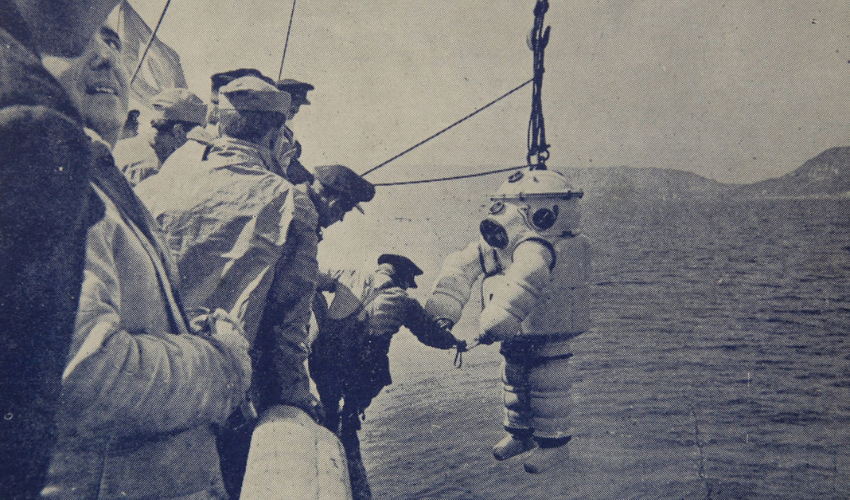Remembering Dumlupinar 71 Years after the maritime tragedy
This year marks the 71st year since the Dumlupinar submarine sank in 1953, taking 81 lives and leaving a lasting imprint on Türkiye’s maritime history
Türkiye commemorates one of its most tragic marine disasters on April 4, the sinking of the Dumlupinar submarine in 1953, which resulted in a significant loss of life.
The Dumlupinar was a Balao-class diesel-electric submarine and began its journey under a different name.
Launched in the United States as the USS Blower on April 23, 1944, it served in the American Navy for six years.
Under the Marshall Plan, it was transferred to Türkiye along with the submarine Canakkale (ex-Bumper) and renamed Dumlupinar on Dec. 9, 1950.
Measuring 95 meters in length, it could reach a speed of 14 knots underwater and was equipped with then-state-of-the-art technology.
Despite its advanced features, the Dumlupinar seemed shadowed by misfortune from its early days.
While in the American Navy, it narrowly escaped sinking on its maiden voyage to Panama because of fog and adverse weather. Throughout World War II, it failed to sink any enemy ships.
In March 1953, the Dumlupinar participated in a major NATO exercise in the Mediterranean alongside the First Inonu Submarine.
After several successful drills, the Dumlupinar and its counterpart were returning to its base in Golcuk when tragedy struck.
The sinking of Dumlupinar in 1953

On the night between April 3 and April 4, 1953, a series of unfortunate events culminated in a maritime disaster.
The Dumlupinar entered the Dardanelles Strait alone after its companion, the First Inonu Submarine, encountered mechanical issues and lagged behind.
With seven crew members, including the commander, Captain Lieutenant Sabri Celebioglu, on the bridge, the journey was initially uneventful.
However, similar to its maiden voyage, a dense fog significantly reduced visibility.
After spending two days submerged for the NATO exercise, the tired crew was unaware of the impending danger.
A Swedish-flagged cargo ship, the Naboland, suddenly appeared out of the fog.
The ship, later reported by Captain Oscard Lorenzon to have mistaken the submarine for a “motorboat,” was rapidly approaching. Efforts to avert a collision were futile.
The Naboland, traveling at 21 knots, and the Dumlupinar were on a collision course.
At approximately 2:15 a.m., the Naboland struck the Dumlupinar on its starboard side near the forward torpedo room.
This collision was heard from the shores of Eceabat and was followed by a massive explosion. Eight crew members on the deck were thrown into the sea, two of whom died instantly as they were caught in the ship’s propellers.
One more drowned in the cold waters of the strait. The remaining five, battling the cold and exhaustion, struggled for survival.
Rescue efforts, casualties in Dumlupinar disaster

The impact grievously damaged the Dumlupinar. It began sinking rapidly, with its stern tilting upward. In mere moments, the submarine turned into a steel tomb, descending into the strait’s depths.
Of the 81 crew members aboard, only 22 survived by sealing themselves in the rear torpedo compartment.
“Collided with an unknown submarine near Canakkale, urgent assistance needed,” the Naboland immediately broadcast a distress signal.
This transmission sparked a nationwide response.
The Turkish Navy mobilized all available resources for a rescue operation, with the vessel Kurtaran, known for rescuing 80 sailors from a sunken ship in the U.S., being dispatched to the site.
The rescue operation’s complexity was compounded by the Dumlupinar’s precarious position – resting at a depth of 80 meters, tilted 15 degrees to starboard.
Divers raced against time and adverse weather to establish a guide rope to the submerged vessel. However, relentless sea currents and poor weather hampered their efforts.
Throughout the nation, people clung to their radios, hoping for good news. At one point, communication was established with the trapped sailors via a buoy released from the submarine.
In a heart-wrenching exchange, Lieutenant Suat attempted to boost the 22 sailors’ morale by instructing them to conserve resources and remain calm.
Despite these brave efforts, time was against them. The submarine’s oxygen supply was dwindling rapidly.
The rescue operation was officially deemed hopeless on April 7, 1953, at 2:15 a.m. The harsh natural conditions had thwarted all rescue attempts, sealing the fate of the 81 servicemen inside the Dumlupinar.
The nation mourned as the Ministry of National Defence announced that all hope for the lives of the 22 trapped sailors had been lost.
Legal, national repercussions of Dumlupinar tragedy

The tragic incident sparked a legal battle that saw the captains of both the Dumlupinar and the Naboland brought to justice.
Captain Oscard Lorenzon of the Naboland faced a six-month prison sentence and a fine, while Captain Lieutenant Sabri Celebioglu of the Dumlupinar was sentenced to a harsher penalty.
The event also led to a nationwide period of mourning. The Turkish government, deeply moved by the tragedy, designated April 4 as the “Deniz Sehitlerini Anma Gunu” (Day of Remembrance for Maritime Martyrs) in honor of the lives lost in the Dumlupinar tragedy.
Source: Newsroom



